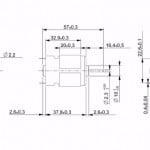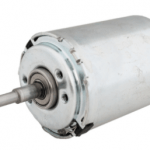Using oversized or undersized geared motors affects the speed reducer’s service life, its efficiency and the proper functioning of its application. When choosing a speed reducer for a specific movement, we must keep well in mind all the operational parameters or needs of the application. Only then can we choose the proper power for our speed reducer and select the one whose specifications offer the best relationship between efficiency, durability and precision.
This may interest you: 5 tips you should know before designing geared motors
The problem with using oversized geared motors
Often times, motors and speed reducers are overpowered/oversized, causing major performance losses during operation, as well as cost overruns during projects. As revealed by a survey by the Automation World magazine, 54% of engineers interviewed claim they still use oversized motors. “Better safe than sorry”, some of them say, while most choose to give the device more power to cover possible variations in the system during its operation.
What are the reasons to use an oversized motor? In summary, it is considered that the cost of a prospective disaster is greater than that of a more efficient motor. Despite this outlook, the fact is that using oversized motors and geared motors results in cost overruns. Do you want to know why?
As a general rule, the motors we use in actuator systems work with loads ranging from 50 to 100% of the rated power, offering the highest performance around 75% of the rated power. When speaking of the motor’s performance, we notice that it drastically drops with loads under 50%, which reveals a negative fact when we use an oversized speed reducer. More specifically, if it doesn’t work under a full load, we will increase power consumption costs. Keep in mind that increases in performance imply energy savings all throughout the motor’s service life to the point of implying savings comparable to the cost of the motor itself (when considering maintenance or refurbishment costs).
In certain applications, it is indeed recommended to work with what we know as the Safety Factor. This is a specification that is calculated by studying the application and its possible workload peaks. By making a calculation involving the necessary power for our motion and the real power delivered by the motor, we can obtain a safety margin that, in certain cases, may result in a competitive advantage for the proper operation of our machine in adverse situations.
When using an oversized speed reducer, we may opt for increasing the gear ratio or increasing the size of the speed reducer. This last option is not recommended for certain applications, since increasing the size may condition the operation once in the machine.
The error of using an undersized geared motor
On the other side of the coin, we find the issue of using an undersized geared motor. This happens when the speed reducer’s specifications do not meet all the requirements for its application. Undersizing is even more damaging than oversizing, since the motor overheats. This issue results in energy and performance losses, and at the same time, leads to a more than certain early failure.
In order to help you know what a gear motor’s wear will be depending on the load conditions of the application, we have the help of the Service Factor. Specifically, this parameter provides us with information about the wear the product will have depending on each application. On the other hand, and unlike the Service Factor, the Safety Factor, as previously mentioned, would help us define a maximum overload for the gear motor.
Thus, using a significantly undersized equipment will always lead us to a Service Factor in excess of 1, which would increase the system and transmission component wear, which in turn would result in a breakdown or early failure.
Don’t miss this article: What is the service factor and how do you calculate it
When faced with an undersized component, we can opt for one of these solutions:
- Change the motor for one with a greater output torque. In this case, a larger motor is used in order to offer the same gear ratio.
- Increase gear ratios.
- The other solution is increasing the size of the gearbox, which allows for an increase in the size of the gear train. Thanks to this, we can manufacture, and work with, gears with a higher module and a greater number of teeth, which increases the gear ratio and the resistance or load capacity of the mechanism.
Conclusion
In order to use a gear motor with the right power we will need a proper mechanical design, and a comprehensive knowledge of the required torque, speed and power. Since each application is different, the methods necessary to properly select the size or specifications of a geared motor vary.
When performing this task, it is very important to perform a highly precise analysis of the torque that is necessary across different transmission phases, whether to endure the various acceleration or deceleration loads; the requirements for continuous motions, or the stopping times where no torque output is required.
In order to select the proper speed reducer, every purchase manager must keep well in mind the level of specialisation of the supplier, his experience, and his capability to adapt to every need. As a gear motor manufacturer, CLR has the necessary know-how to design and size speed reducers and various actuators.
As a result of its experience in industries as complex as the automotive industry and its technological capabilities in machining and injection moulding, the company is not only capable of designing a solution, but it also has the means to industrialise the product and manufacture it in house. Do you need assistance to choose a speed reducer for your projects? Download our basic guide about speed reducers selection or contact our team of Project Managers.












The trick with electric motors, which confuses the thinking of many, is some simple arithmetic and engineering is required to understand the operation. The fan boy myths are thick. Very generally, the Watts you put in is the HP you get out. The trick is matching the load. Larger motors are probably not any more efficient all else being equal.